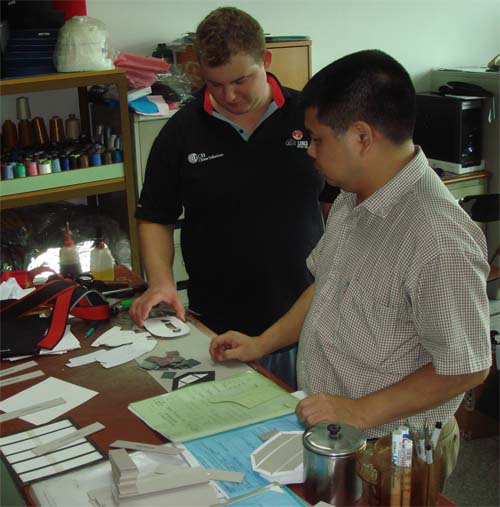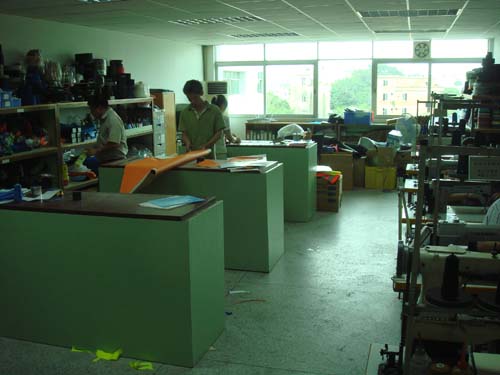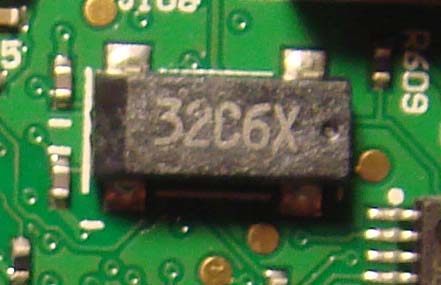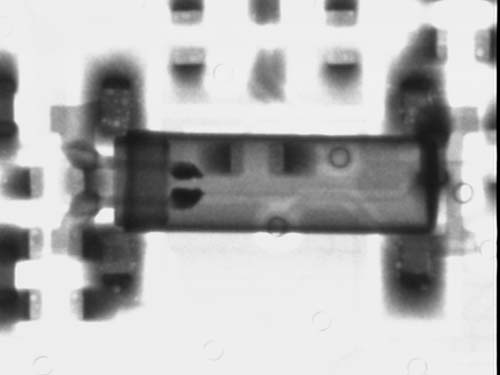I’d like to introduce you to a man who I know simply as “Master Chao”.

Master Chao is the person in the foreground; in the background is Joe Perrott, who you will see in many of the photos and videos I have from China. Joe is our excellent project engineer from PCH China Solutions. But I digress.
Why am I introducing you to Master Chao? Because I’m pretty sure you have used or seen something in your lifetime that was crafted by the Master. When I went to the sample room for this factory, I was shocked at how many items I saw on their shelf that I had myself purchased, used, or seen in a store in the US — top-tier consumer brands manufacture their stuff here — and to the best of my knowledge the factory has just one master pattern maker, and this is him. Indulge me with a moment of philosophy.
The advent of modern CAD tools have brought about a rather coarse attitude towards the arts and crafts. It used to be that the finest furniture was designed and built only with the intuition and skill of a master craftsman; now, we all go to Ikea and get our CAD-designed, supply chain managed, picture-book assembly furniture kits and despite all that it doesn’t look too shabby. As a result, the word “craft” has been relegated to describe some scrapbook or needlepoint kit you buy at Michaels and put together on a slow weekend. We’ve sort of forgotten that in an age before machines, “craft” was the only way that anything of any quality used to be built.
It turns out there are still things where Craft, and I use it with a capital “C” here, matters–it’s where CAD tools haven’t brought about the ability to simulate out our mistakes before we build them. The creation of a flat pattern for textile goods is a good example of a process that requires a Craftsman. A flat pattern is the set of 2-D shapes used to guide the cutting of fabrics. These 2-D shapes are cut, folded and sewn into a complex 3-D shape. Mapping the projection of an arbitrary 3-D shape onto a 2-D surface with minimal waste area between the pieces is hard enough; the fact that the material stretches and distorts, sometimes in an anisotropic fashion, and the fact that sewing requires ample tolerances for good yields makes it a difficult problem to automate. On the chumby, we add another level of complexity, because we sew a piece of leather onto a soft plastic frame. As you sew the leather on, the frame will distort slightly and stretch the leather out, creating a sewing bias dependent upon the direction and rate of sewing. This force is captured in the seams and contributes to the final shape of the device. I challenge someone to make a computer simulation tool that can accurately capture those forces and predict how a device will look at the end of the day.
Yet, somehow, Master Chao’s proficiency in the art of pattern making enables him to very quickly, and in very few iterations, create and tweak a pattern that compensates for all of this. It’s astounding how clever and how insightful the results can be. And really, the point of this particular post is to introduce you to a person whose old-world skills — absent computers, all done with cardboard, scissors and pencils — has likely played a role in the production of something that you have used or benefited from in the course of your life.

Not a single computer in this office, yet the products developed here wrap around a wide array of high-tech products.





